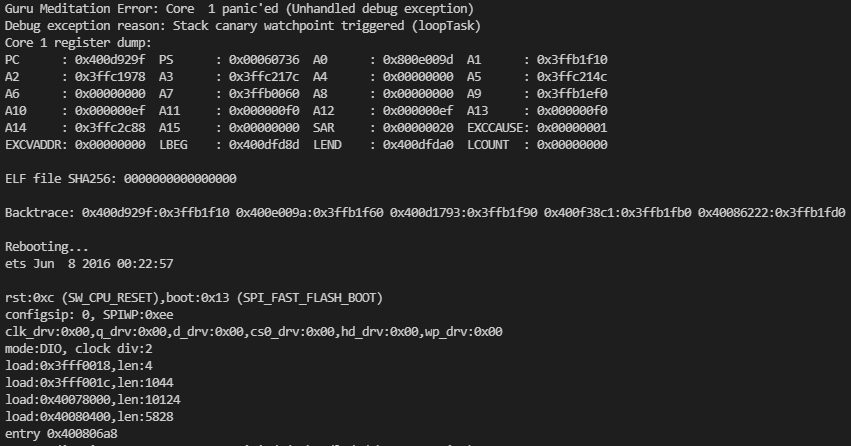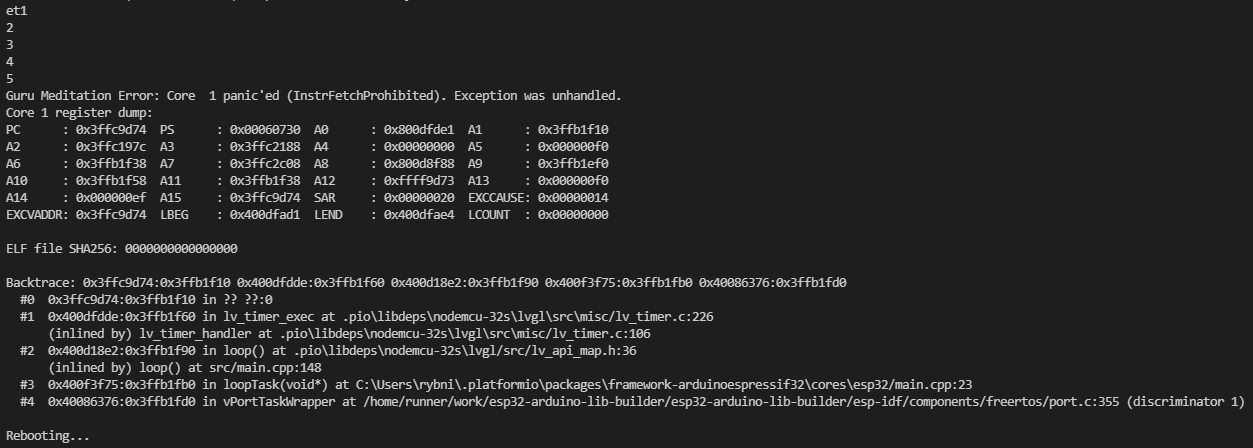patryb
July 29, 2021, 11:46am
1
Hi,
could you please help me with this kind of usual-looking error so I can run the LVGL library? After I upload my code for ESP32 in PlatformIO it always gives me this kind of error:
I was going through some similar problems in the forum, but I wasn’t able to do anything with that.
NodeMCU ESP32
LVGL 8.0.1
After uploading the code, the screen is just blinking, so I would like to run this simple sketch on my ILI9341 display.
#include <Arduino.h>
#include <lvgl.h>
#include <TFT_eSPI.h>
TFT_eSPI tft = TFT_eSPI(); /* TFT instance */
static lv_disp_draw_buf_t disp_buf;
static lv_color_t buf[LV_HOR_RES_MAX * 10];
int screenWidth = 320;
int screenHeight = 240;
/* Display flushing */
void my_disp_flush(lv_disp_drv_t *disp_drv, const lv_area_t *area, lv_color_t *color_p)
{
uint32_t w = (area->x2 - area->x1 + 1);
uint32_t h = (area->y2 - area->y1 + 1);
tft.startWrite();
tft.setAddrWindow(area->x1, area->y1, w, h);
tft.pushColors(&color_p->full, w * h, true);
tft.endWrite();
lv_disp_flush_ready(disp_drv);
}
void my_touchpad_read(lv_indev_drv_t * indev_driver, lv_indev_data_t * data)
{
uint16_t touchX, touchY;
bool touched = tft.getTouch(&touchX, &touchY, 600);
if(!touched)
{
//return false;
}
if(touchX>screenWidth || touchY > screenHeight)
{
Serial.println("Y or y outside of expected parameters..");
Serial.print("y:");
Serial.print(touchX);
Serial.print(" x:");
Serial.print(touchY);
}
else
{
data->state = touched ? LV_INDEV_STATE_PR : LV_INDEV_STATE_REL;
/*Save the state and save the pressed coordinate*/
//if(data->state == LV_INDEV_STATE_PR) touchpad_get_xy(&last_x, &last_y);
/*Set the coordinates (if released use the last pressed coordinates)*/
data->point.x = touchX;
data->point.y = touchY;
Serial.print("Data x");
Serial.println(touchX);
Serial.print("Data y");
Serial.println(touchY);
}
//return false; /*Return `false` because we are not buffering and no more data to read*/
}
void setup()
{
Serial.begin(115200); /* prepare for possible serial debug */
lv_init();
tft.begin(); /* TFT init */
tft.setRotation(1); /* Landscape orientation */
uint16_t calData[5] = {196, 3676, 256, 3856, 1};
tft.setTouch(calData);
lv_disp_draw_buf_init(&disp_buf, buf, NULL, LV_HOR_RES_MAX * 10);
/*Initialize the display*/
lv_disp_drv_t disp_drv;
lv_disp_drv_init(&disp_drv);
disp_drv.draw_buf = &disp_buf;
disp_drv.flush_cb = my_disp_flush;
disp_drv.hor_res = 320;
disp_drv.ver_res = 240;
lv_disp_drv_register(&disp_drv); /*Register the driver and save the created display objects*/
/*Initialize the input device driver*/
lv_indev_drv_t indev_drv;
lv_indev_drv_init(&indev_drv); /*Descriptor of a input device driver*/
indev_drv.type = LV_INDEV_TYPE_POINTER; /*Touch pad is a pointer-like device*/
indev_drv.read_cb = my_touchpad_read; /*Set your driver function*/
lv_indev_drv_register(&indev_drv); /*Finally register the driver*/
/* Create simple label */
lv_obj_t *label = lv_label_create(lv_scr_act());
lv_label_set_text(label, "Hello Arduino! (V7.0.X)");
lv_obj_align(label, LV_ALIGN_CENTER, 0, 0);
}
void loop()
{
lv_task_handler(); /* let the GUI do its work */
delay(1);
}
You should set the lv_tick_handler . This code works for me, If you can’t run it, try to run ESPexceptionDecoder
#include <lvgl.h>
#include <Ticker.h>
#include <TFT_eSPI.h>
#define LVGL_TICK_PERIOD 10
Ticker tick; /* timer for interrupt handler */
TFT_eSPI tft = TFT_eSPI();
uint16_t calData[5] = { 464, 3363, 307, 3419, 1 };
/* Serial debugging */
void my_print(lv_log_level_t level, const char * file, uint32_t line, const char * dsc)
{
Serial.printf("%s@%d->%s\r\n", file, line, dsc);
Serial.flush();
}
#endif
/* Display flushing */
void my_disp_flush(lv_disp_drv_t *disp, const lv_area_t *area, lv_color_t *color_p)
{
uint32_t w = (area->x2 - area->x1 + 1);
uint32_t h = (area->y2 - area->y1 + 1);
tft.startWrite();
tft.setAddrWindow(area->x1, area->y1, w, h);
tft.pushColors(&color_p->full, w * h, true);
tft.endWrite();
lv_disp_flush_ready(disp);
}
bool my_touchpad_read(lv_indev_drv_t * indev_driver, lv_indev_data_t * data)
{
uint16_t touchX, touchY;
bool touched = tft.getTouch(&touchX, &touchY, 600);
if(!touched)
{
data->state = LV_INDEV_STATE_REL;
return false;
}
else
{
data->state = LV_INDEV_STATE_PR;
}
if(touchX>screenWidth || touchY > screenHeight)
{
Serial.println("Y or y outside of expected parameters..");
Serial.print("y:");
Serial.print(touchX);
Serial.print(" x:");
Serial.print(touchY);
}
else
{
/*Set the coordinates*/
data->point.x = touchX;
data->point.y = touchY;
Serial.print("Data x");
Serial.println(touchX);
Serial.print("Data y");
Serial.println(touchY);
}
return false; /*Return `false` because we are not buffering and no more data to read*/
}
static void lv_tick_handler(void)
{
lv_tick_inc(LVGL_TICK_PERIOD);
}
void setup()
{
Serial.begin(115200); /* prepare for possible serial debug */
lv_init();
tft.begin(); /* TFT init */
tft.setRotation(1); /* Landscape orientation */
uint16_t calData[5] = {196, 3676, 256, 3856, 1};
tft.setTouch(calData);
lv_disp_draw_buf_init(&disp_buf, buf, NULL, LV_HOR_RES_MAX * 10);
/*Initialize the display*/
lv_disp_drv_t disp_drv;
lv_disp_drv_init(&disp_drv);
disp_drv.draw_buf = &disp_buf;
disp_drv.flush_cb = my_disp_flush;
disp_drv.hor_res = 320;
disp_drv.ver_res = 240;
lv_disp_drv_register(&disp_drv); /*Register the driver and save the created display objects*/
/*Initialize the input device driver*/
lv_indev_drv_t indev_drv;
lv_indev_drv_init(&indev_drv); /*Descriptor of a input device driver*/
indev_drv.type = LV_INDEV_TYPE_POINTER; /*Touch pad is a pointer-like device*/
indev_drv.read_cb = my_touchpad_read; /*Set your driver function*/
lv_indev_drv_register(&indev_drv); /*Finally register the driver*/
tick.attach_ms(LVGL_TICK_PERIOD, lv_tick_handler);
xSemaphore = xSemaphoreCreateMutex(); //mutex to handle the processes
/* Create simple label */
lv_obj_t *label = lv_label_create(lv_scr_act());
lv_label_set_text(label, "Hello Arduino! (V7.0.X)");
lv_obj_align(label, LV_ALIGN_CENTER, 0, 0);
}
void loop()
{
xSemaphoreTake(xSemaphore, portMAX_DELAY);
lv_task_handler ();
xSemaphoreGive(xSemaphore);
delay(5);
}
1 Like
patryb
July 29, 2021, 12:14pm
3
Thanks, but this code shows me that the xSemaphore is not defined.
patryb
July 29, 2021, 1:48pm
5
Yeah, true, still trying to solve it, but it’s not working… anyone else with some idea?
I found out how to read the backtrace (something like ESPexceptionDecoder ) and it shows this:
Used code:
#include <Arduino.h>
#include <lvgl.h>
#include <Ticker.h>
#include <TFT_eSPI.h>
#define LVGL_TICK_PERIOD 20
Ticker tick; /* timer for interrupt handler */
TFT_eSPI tft = TFT_eSPI(); /* TFT instance */
static lv_disp_draw_buf_t disp_buf;
static lv_color_t buf[LV_HOR_RES_MAX * 10];
int screenWidth = 320;
int screenHeight = 240;
#if USE_LV_LOG != 0
/* Serial debugging */
void my_print(lv_log_level_t level, const char * file, uint32_t line, const char * dsc)
{
Serial.printf("%s@%d->%s\r\n", file, line, dsc);
delay(100);
}
#endif
/* Display flushing */
void my_disp_flush(lv_disp_drv_t *disp, const lv_area_t *area, lv_color_t *color_p)
{
uint16_t c;
tft.startWrite(); /* Start new TFT transaction */
tft.setAddrWindow(area->x1, area->y1, (area->x2 - area->x1 + 1), (area->y2 - area->y1 + 1)); /* set the working window */
for (int y = area->y1; y <= area->y2; y++) {
for (int x = area->x1; x <= area->x2; x++) {
c = color_p->full;
tft.writeColor(c, 1);
color_p++;
}
}
tft.endWrite(); /* terminate TFT transaction */
lv_disp_flush_ready(disp); /* tell lvgl that flushing is done */
}
/* Interrupt driven periodic handler */
static void lv_tick_handler(void)
{
lv_tick_inc(LVGL_TICK_PERIOD);
}
void my_touchpad_read(lv_indev_drv_t * indev_driver, lv_indev_data_t * data)
{
uint16_t touchX, touchY;
bool touched = tft.getTouch(&touchX, &touchY, 600);
if(!touched)
{
//return false;
}
if(touchX>screenWidth || touchY > screenHeight)
{
Serial.println("Y or y outside of expected parameters..");
Serial.print("y:");
Serial.print(touchX);
Serial.print(" x:");
Serial.print(touchY);
}
else
{
data->state = touched ? LV_INDEV_STATE_PR : LV_INDEV_STATE_REL;
/*Save the state and save the pressed coordinate*/
//if(data->state == LV_INDEV_STATE_PR) touchpad_get_xy(&last_x, &last_y);
/*Set the coordinates (if released use the last pressed coordinates)*/
data->point.x = touchX;
data->point.y = touchY;
Serial.print("Data x");
Serial.println(touchX);
Serial.print("Data y");
Serial.println(touchY);
}
//return false; /*Return `false` because we are not buffering and no more data to read*/
}
void setup()
{
Serial.begin(115200); /*prepare for possible serial debug*/
lv_init();
#if USE_LV_LOG != 0
lv_log_register_print(my_print); /* register print function for debugging */
#endif
tft.begin(); /*TFT init*/
tft.setRotation(1); /*Landscape orientation*/
uint16_t calData[5] = {196, 3676, 256, 3856, 1};
tft.setTouch(calData);
lv_disp_draw_buf_init(&disp_buf, buf, NULL, LV_HOR_RES_MAX * 10);
/*Initialize the display*/
lv_disp_drv_t disp_drv;
lv_disp_drv_init(&disp_drv);
disp_drv.draw_buf = &disp_buf;
disp_drv.flush_cb = my_disp_flush;
disp_drv.hor_res = 320;
disp_drv.ver_res = 240;
lv_disp_drv_register(&disp_drv); /*Register the driver and save the created display objects*/
/*Initialize the graphics library's tick*/
tick.attach_ms(LVGL_TICK_PERIOD, lv_tick_handler);
/*Initialize the input device driver*/
lv_indev_drv_t indev_drv;
lv_indev_drv_init(&indev_drv); /*Descriptor of a input device driver*/
indev_drv.type = LV_INDEV_TYPE_POINTER; /*Touch pad is a pointer-like device*/
indev_drv.read_cb = my_touchpad_read; /*Set your driver function*/
lv_indev_drv_register(&indev_drv); /*Finally register the driver*/
/*Create simple label*/
lv_obj_t *label = lv_label_create(lv_scr_act());
lv_label_set_text(label, "Hello Arduino!");
lv_obj_align(label, LV_ALIGN_CENTER, 0, 0);
}
void loop()
{
lv_task_handler ();
delay(5);
}
add #include <freertos/semphr.h>
elgerg
July 29, 2021, 3:31pm
7
Try putting some serial prints in to see where it gets up to. You could also have a power supply thats not providing enough power.
Sorry you must define the semaphore:
SemaphoreHandle_t xSemaphore = NULL;
Your exception its to weird, are you tryed with other esp32? Is it possible that you have a short circuit? Or less than the recommended power supply?
patryb
July 30, 2021, 8:03am
9
Even with the semaphore it does not work
Maybe I will try different ESP, because the power supply is totally ok.
patryb
July 30, 2021, 8:06am
10
It always breaks up in the loop…
#include <Arduino.h>
#include <lvgl.h>
#include <Ticker.h>
#include <TFT_eSPI.h>
#define LVGL_TICK_PERIOD 20
Ticker tick; /* timer for interrupt handler */
TFT_eSPI tft = TFT_eSPI(); /* TFT instance */
static lv_disp_draw_buf_t disp_buf;
static lv_color_t buf[LV_HOR_RES_MAX * 10];
int screenWidth = 320;
int screenHeight = 240;
#if USE_LV_LOG != 0
/* Serial debugging */
void my_print(lv_log_level_t level, const char * file, uint32_t line, const char * dsc)
{
Serial.printf("%s@%d->%s\r\n", file, line, dsc);
delay(100);
}
#endif
/* Display flushing */
void my_disp_flush(lv_disp_drv_t *disp, const lv_area_t *area, lv_color_t *color_p)
{
uint16_t c;
tft.startWrite(); /* Start new TFT transaction */
tft.setAddrWindow(area->x1, area->y1, (area->x2 - area->x1 + 1), (area->y2 - area->y1 + 1)); /* set the working window */
for (int y = area->y1; y <= area->y2; y++) {
for (int x = area->x1; x <= area->x2; x++) {
c = color_p->full;
tft.writeColor(c, 1);
color_p++;
}
}
tft.endWrite(); /* terminate TFT transaction */
lv_disp_flush_ready(disp); /* tell lvgl that flushing is done */
}
/* Interrupt driven periodic handler */
static void lv_tick_handler(void)
{
lv_tick_inc(LVGL_TICK_PERIOD);
}
void my_touchpad_read(lv_indev_drv_t * indev_driver, lv_indev_data_t * data)
{
uint16_t touchX, touchY;
bool touched = tft.getTouch(&touchX, &touchY, 600);
if(!touched)
{
//return false;
}
if(touchX>screenWidth || touchY > screenHeight)
{
Serial.println("Y or y outside of expected parameters..");
Serial.print("y:");
Serial.print(touchX);
Serial.print(" x:");
Serial.print(touchY);
}
else
{
data->state = touched ? LV_INDEV_STATE_PR : LV_INDEV_STATE_REL;
/*Save the state and save the pressed coordinate*/
//if(data->state == LV_INDEV_STATE_PR) touchpad_get_xy(&last_x, &last_y);
/*Set the coordinates (if released use the last pressed coordinates)*/
data->point.x = touchX;
data->point.y = touchY;
Serial.print("Data x");
Serial.println(touchX);
Serial.print("Data y");
Serial.println(touchY);
}
//return false; /*Return `false` because we are not buffering and no more data to read*/
}
void setup()
{
Serial.begin(115200); /*prepare for possible serial debug*/
lv_init();
#if USE_LV_LOG != 0
lv_log_register_print(my_print); /* register print function for debugging */
#endif
Serial.println("1");
tft.begin(); /*TFT init*/
tft.setRotation(1); /*Landscape orientation*/
uint16_t calData[5] = {196, 3676, 256, 3856, 1};
tft.setTouch(calData);
lv_disp_draw_buf_init(&disp_buf, buf, NULL, LV_HOR_RES_MAX * 10);
Serial.println("2");
/*Initialize the disply*/
lv_disp_drv_t disp_drv;
lv_disp_drv_init(&disp_drv);
disp_drv.draw_buf = &disp_buf;
disp_drv.flush_cb = my_disp_flush;
disp_drv.hor_res = 320;
disp_drv.ver_res = 240;
lv_disp_drv_register(&disp_drv); /*Register the driver and save the created display objects*/
/*Initialize the graphics library's tick*/
tick.attach_ms(LVGL_TICK_PERIOD, lv_tick_handler);
Serial.println("3");
/*Initialize the input device driver*/
lv_indev_drv_t indev_drv;
lv_indev_drv_init(&indev_drv); /*Descriptor of a input device driver*/
indev_drv.type = LV_INDEV_TYPE_POINTER; /*Touch pad is a pointer-like device*/
indev_drv.read_cb = my_touchpad_read; /*Set your driver function*/
lv_indev_drv_register(&indev_drv); /*Finally register the driver*/
/*Create simple label*/
lv_obj_t *label = lv_label_create(lv_scr_act());
lv_label_set_text(label, "Hello Arduino!");
lv_obj_align(label, LV_ALIGN_CENTER, 0, 0);
Serial.println("4");
}
void loop()
{
Serial.println("5");
lv_task_handler ();
delay(5);
Serial.println("6");
}
patryb
July 30, 2021, 8:50am
11
After putting it to ArduinoIDE and analyzing it with ESPexceptionDecoder, it shows this:
The same problem occurred on my board, the Board will run properly lvgl7
1 Like
What is the pin configuration of the ili9341? Are you sure the declarations in TFT_eSPI are correct? The code I sent you works for me with a 240x320 ILI9341 display and ESP32 nodeMCU with this pin configuration:
#define TFT_MISO 19
#define TFT_MOSI 23
#define TFT_SCLK 18
#define TFT_CS 5
#define TFT_DC 4
#define TFT_RST 22
#define TOUCH_CS 14
Do you have your lv_conf.h statements okay?
/* Maximal horizontal and vertical resolution to support by the library.*/
#define LV_HOR_RES_MAX (240)
#define LV_VER_RES_MAX (320)
1 Like
patryb
July 30, 2021, 9:30am
14
The TFT_eSPI is definitely correct, because all the TFT_eSPI examples work just fine. My conf is this:
#define TFT_MISO 19
#define TFT_MOSI 23
#define TFT_SCLK 18
#define TFT_CS 15
#define TFT_DC 2
#define TFT_RST 4
#define TOUCH_CS 21
And the lv.conf.h statemenst are also correct.
Try with lvgl 7 for check if it works
1 Like
patryb
July 30, 2021, 12:12pm
16
Yeah, it’s exactly as you say, the latest v7 is working just fine, but both v8.0 or v8.1 are damaged for my ESP. I will definitely try different controler because I’d like to use the latest version of LVGL, but for now, I think it will be enough.
Thank you all for your effort, especially @Alvaro_Mourazo for your time!
Hopefully there won’t be such problems for next versions. Thanks again!
1 Like





